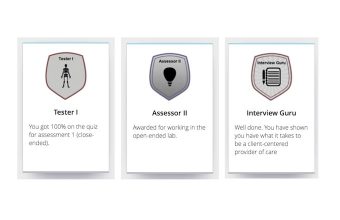Stress Relief Through Badging

Source: Iain Robertson
The Resource
Badging is an alternative approach to traditional methods of indicating accomplishments, skills, or quality of work. Several open badging systems are available.
Why I Set Out to Build This Resource
I had developed and been using fairly traditional methods of test preparation for my learners taking the Registered Massage exams. These involved administering multiple mock written exams as practice and providing feedback on the subjective elements of skill demonstration and patient interaction. I found that these approaches did not put learners at ease or boost their confidence as effectively as I’d hoped. I sought an alternative approach with the help of collaborators to provide opportunities for learners to self-regulate practice on quizzes and explore the diversity of practice decisions with peers in a safe environment. I landed on the use of badges as one way to gamify these tasks and increase learner engagement. My approach focused on formative, practical work that required significant perseverance and creativity.
The use of badges turned out to be a method of reducing stress—for both learners and me!
How I Did It
I found a variety of badging systems available outside of institutional learning management systems to choose from. I chose Passport, a system developed at Purdue University that was free to use at the time I began my badging practice. It is now a paid service, but there are many options in the badging world.
I developed three levels of badges:
- Level 1 badges were grounded in weekly readings and quizzes that learners could take as many times as needed to achieve 100%. Learners were also invited to ask their peers for help if they were stuck on a particular question.
- Level 2 badges were tied to weekly three-hour lab activities: physical hands-on practice and discussion related to the planning and technique elements of massage therapy practice.
- Level 3 badges were used in a variety of ways that required learners to reflect and synthesize their program knowledge in the form of quiz questions and practice scenarios for everyone to use. Learners also engaged in role play and open-ended questioning that simulated what they might experience as part of their observational exams. Learners could make mistakes, explore how their responses might be grounded more effectively in the science of their profession, and refine their skills until they felt confident in their ability to complete their real-world testing.
With a good user interface, I found badges relatively simple to design and easy to manage in terms of adding learners and tracking their progress through my learning management system. My badging strategy has resulted in a significant positive difference in the success of my learners in their professional exams, and I will continue to consider ways that I can improve my use of this tool and pedagogic strategy to build learner confidence.
Access
Some new and open options that you might try include the following:
- Open Badge Passport: https://openbadgepassport.com/
- Badgr: https://info.badgr.io/
- Badgr Help Page on YouTube: https://tinyurl.com/BadgrHelp
Contributed by
Iain Robertson, Georgian College


Feedback/Errata